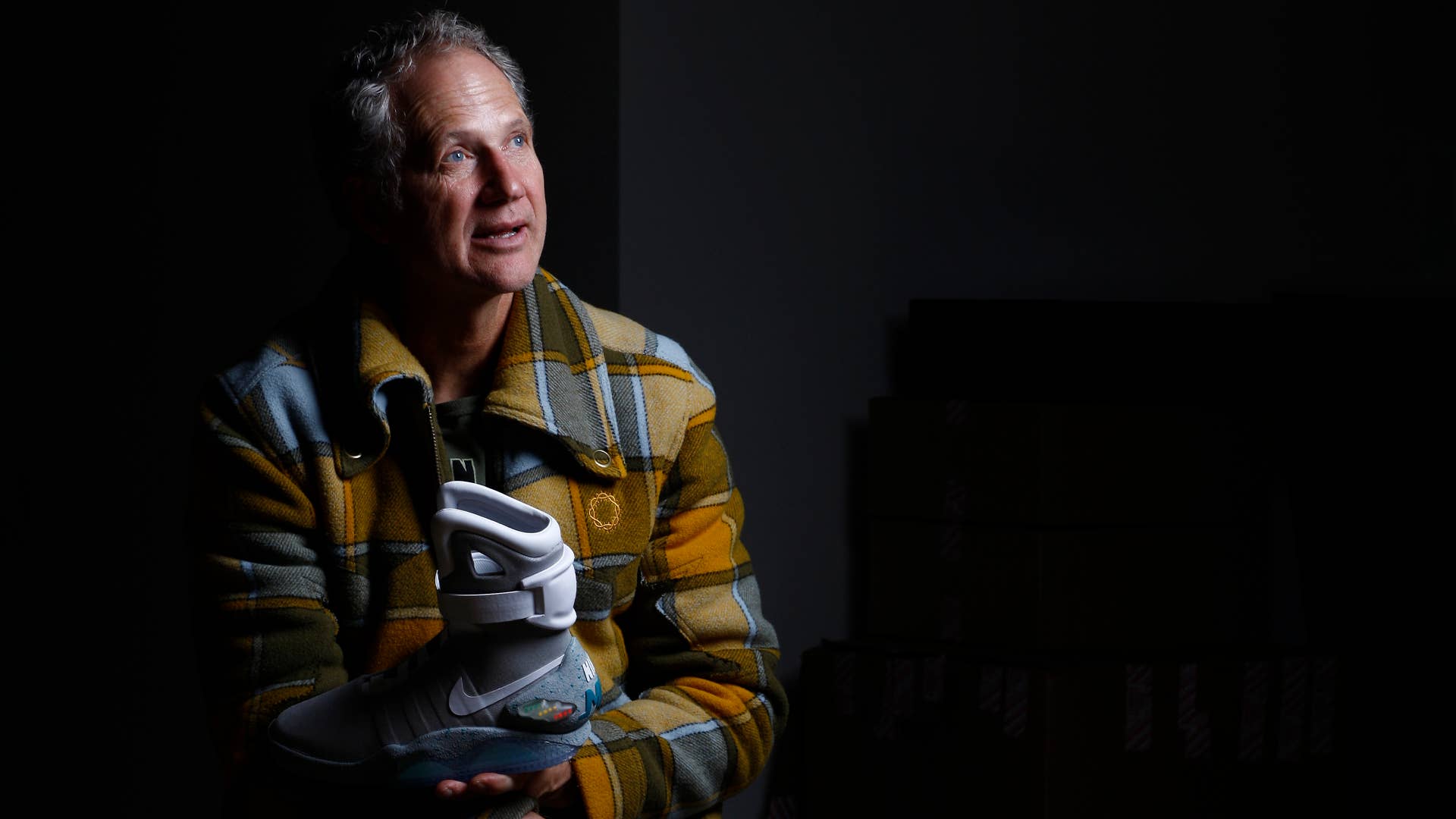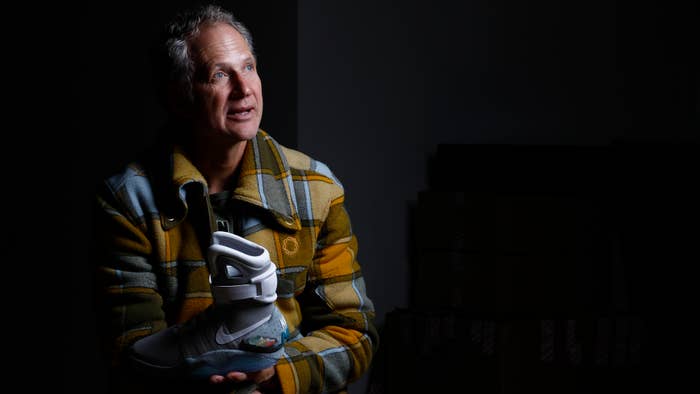
Tinker Hatfield has done it all, although he’s doing his best not to these days.
The storied designer, who started out at Nike in 1981 as an architect before transitioning to footwear design in 1985, helped keep Michael Jordan at the brand in that decade, made Marty McFly’s Back to the Future Part II sneakers, and changed the way running shoes looked. His entries in the Air Jordan and Air Max lines are icons not just of sneaker culture, but of pop culture. Hatfield is a mad scientist, but never a manic one––the enthusiasm that he lets out not quite bursting through his measured tone. His work includes buildings, a basketball court, and university brand marks.
At this point, 40 years into his career and still facing a flood of solicitations for his technique and taste, he is trying to do less.
“It’s very frustrating,” he says. “I try to be really judicious with the choices outside of Nike and also I have to be judicious with the Nike projects, too, because the quality has to be high. I have to put the brakes on sometimes, so that I’m not overstretched to the point that the work isn’t as good.”
Inside of Nike he is the global sportswear brand’s vice president of design and special projects. There he is among a dwindling few of the true Swoosh old guard, one who still seems more comfortable as maverick designer than brand-safe pitch man, although he’ll play either role when duty calls. He speaks about his work freely and with a sense of fun, making him a more full character than most sportswear execs. Outside of Nike, his latest gig is with Michelob Ultra, for whom he’s designed a run of limited-edition beer bottles made to commemorate the 2021 NBA Finals.
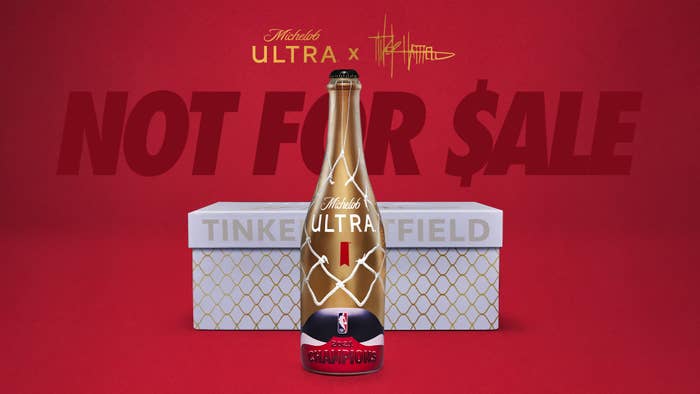
The bottles are inspired partly by the Larry O’Brien NBA Championship Trophy and come in packaging mimicking a sneaker box. They will be hand-signed by Hatfield and individually numbered, their count determined by the final score of the winning team in the last game of the 2021 NBA Finals. He is donating his design fee for the project to a Chicago charity on his own behalf. The “not for sale” bottles will be available via a drop clock hosted here and on the Michelob Ultra Twitter account that will go live once the deciding game concludes. As part of the promotion, Hatfield will host an ask me anything session on Reddit during Game 3 of the series.
These opportunities are afforded partly by a pandemic-imposed work schedule that has the Nike designer spending less time commuting and more time actually designing. That’s not to say that his work has slowed in the last year and a half, though.
“Mentally, it’s been more hectic than I can remember, actually,” he says.
The frantic nature of life lately has not altered Hatfield’s image of the focused Nike sage. But he is not near idle––he still reads as eager as he approaches 70. In the interview below, he discusses his project with Michelob Ultra, celebrating championships with Michael Jordan during his reign in the NBA, and how quarantine affected his work habits. The conversation has been lightly edited and condensed for clarity.
How different is this project from working on a sneaker? Do you have to access different parts of your brain for something like this?
I don’t think I had to access any different part of my brain. Because it’s really a two-step process, which is, you have to develop a concept that you think will be interesting, maybe in this case visible, highly visible, and unique. And then of course there is the second phase of any project, and it’s the same in footwear, where you have to sort of go through the blocking and tackling of getting everything executed properly.
So, it was very similar to designing a shoe, although, I don’t want to demean the complexities of trying to help an NBA player jump higher, and run faster, and be safer. There are a few more—let’s just say, there are a few more complexities to that, and I don’t want that to go unmentioned. But, same process, just there’s a longer and more complicated part to performance footwear. Let’s put it that way.
And how much time in 2021 does Tinker Hatfield spend working on footwear at Nike, versus working on side projects like this?
Oh, I choose very few. I don’t choose side projects very often. But, in this particular case, I felt like there was an opportunity here to give back to a charity in Chicago called CHAMPS, which is one of my favorite charities. It’s an after-school program for inner-city youth; a safe haven for them to go and study, and maybe play sports, so that was one motivation.
But the other is, I think what Michelob does, and Michelob Ultra in particular, is classy. They do a great job of presenting themselves. And I think the brand is all about fun for their consumers and the brand itself. And I’m excited about partnering with people like that, with companies like that. I said yes because of those parameters, or those issues.
You started out as an architect, and then you shifted to being a sneaker designer, and now you’re kind of shifting, at least for this project, into a different role. Did you ever expect to be designing a bottle?
I can honestly say that I never, ever, thought that I’d be designing a beer bottle. Or any kind of bottle, for that matter. But, having said that, people ask me all the time about, “Well, what was it like to shift from architecture to footwear?” And I’ve done a lot of apparel at Nike, too. Not so much recently, but over the years. And essentially the design process is always pretty similar. There are variations on the complexity but, as we just talked about, it’s all pretty similar.
I feel like, at the University of Oregon Architecture School, they really helped me understand design from a holistic perspective. And, it almost doesn’t matter what it is. I’ve recently just designed a show motorcycle, and that was: I ride motorcycles, no problem. So, if you have some personal insight, plus that design education, and a process locked in. [You can] pretty much sit down and design anything.
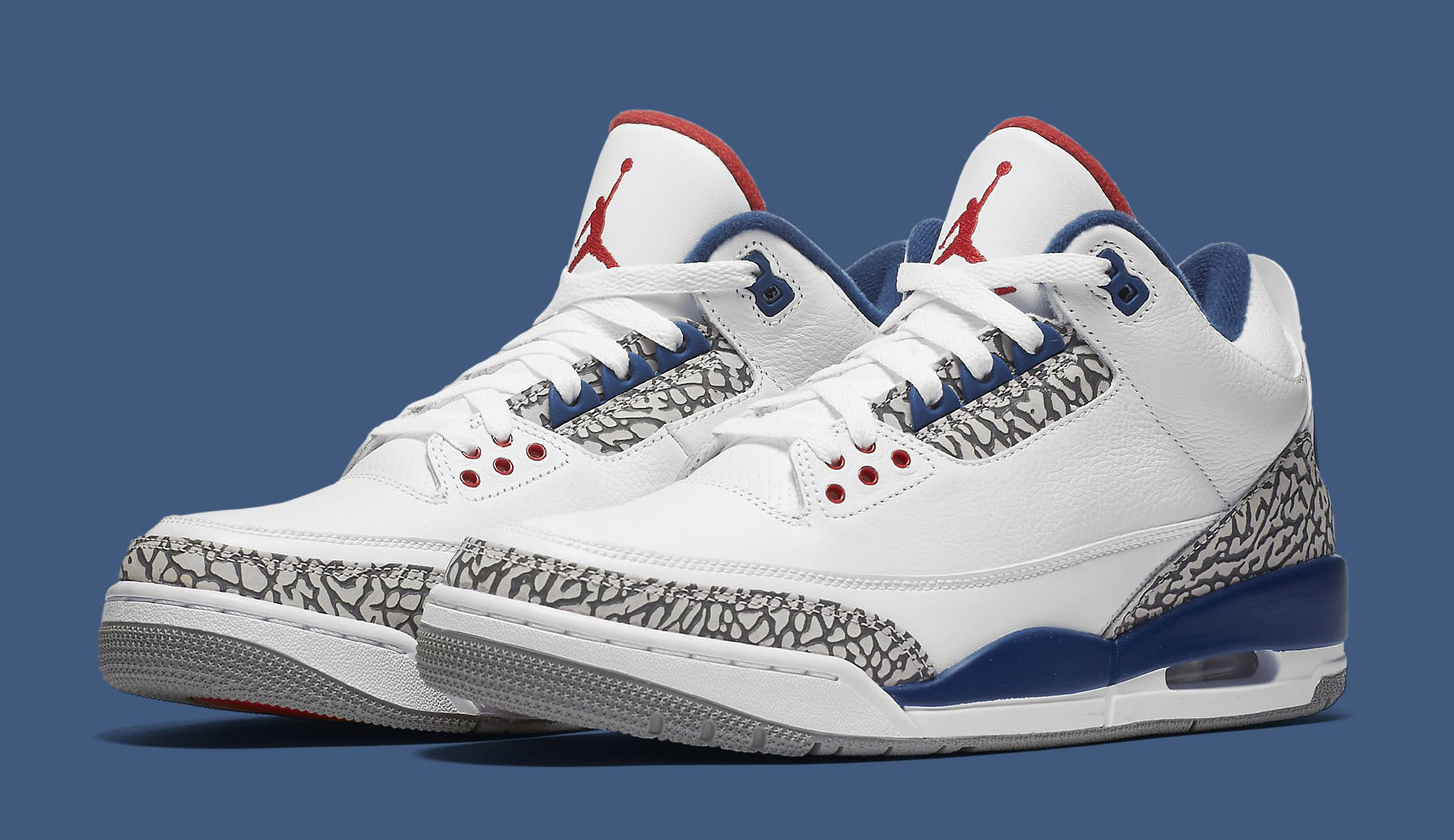
Do things like the beer bottle and the motorcycle feed back into your footwear and apparel work?
It very possibly could. I often say that when I sit down to design something, and most of the time it is footwear, I make this statement that what I’m drawing, and what I’m thinking about is really a culmination of everything that I’ve seen and done in my life up to that point. And, I think that’s one reason why I don’t really get designer’s block or get stuck. Because I keep expanding the experiences that I engage in, and it just continues to give me more, I guess you could say, more inspiration to do new designs.
You must have had plenty of inspiration to draw from here, being associated with people like Michael Jordan, and championship squads, like the Chicago Bulls in the ‘90s. You were right there during those runs. Were you celebrating with them at all?
Oh, yeah. Yeah, I was around a lot, and I would sometimes be in the locker room after the games. Usually, if it was a home game, I would spend the night, or maybe two or three nights, with Michael at his house. It was just sort of like family. That’s when you can do the best work, when you know people really well. So, it was really exciting to be involved peripherally with the teams, in this case, the Bulls were awesome, because it was such a huge lift to the city, that the Bulls were winning and Michael was playing so well. To see that up close and personal and see how it affected people’s lives, how much fun it was for the people of Chicago was just priceless. It was really cool.
It also sets up an interesting timeline, too, of how soon after a championship do you go back to work on footwear with Michael for the next phase of things?
Oh, but I’m already working on the next shoe before the championship even starts. So, the design process, I’m sure you’re aware, it’s roughly about an 18-month process from concept, to delivery to a store. We live in the future, in that regard.
When the championship starts though, I am actually going to the championships, or involved with a player like Michael Jordan, I’ll pause, I’ll take a pause. But, I think I’m right back at the drawing board—in this case, now an iPad—and in minutes, after the game’s over, it’s kind of like, just keep rolling. Just keep rolling, and maybe even use the enthusiasm and the excitement of the championships to add more energy to the design process.
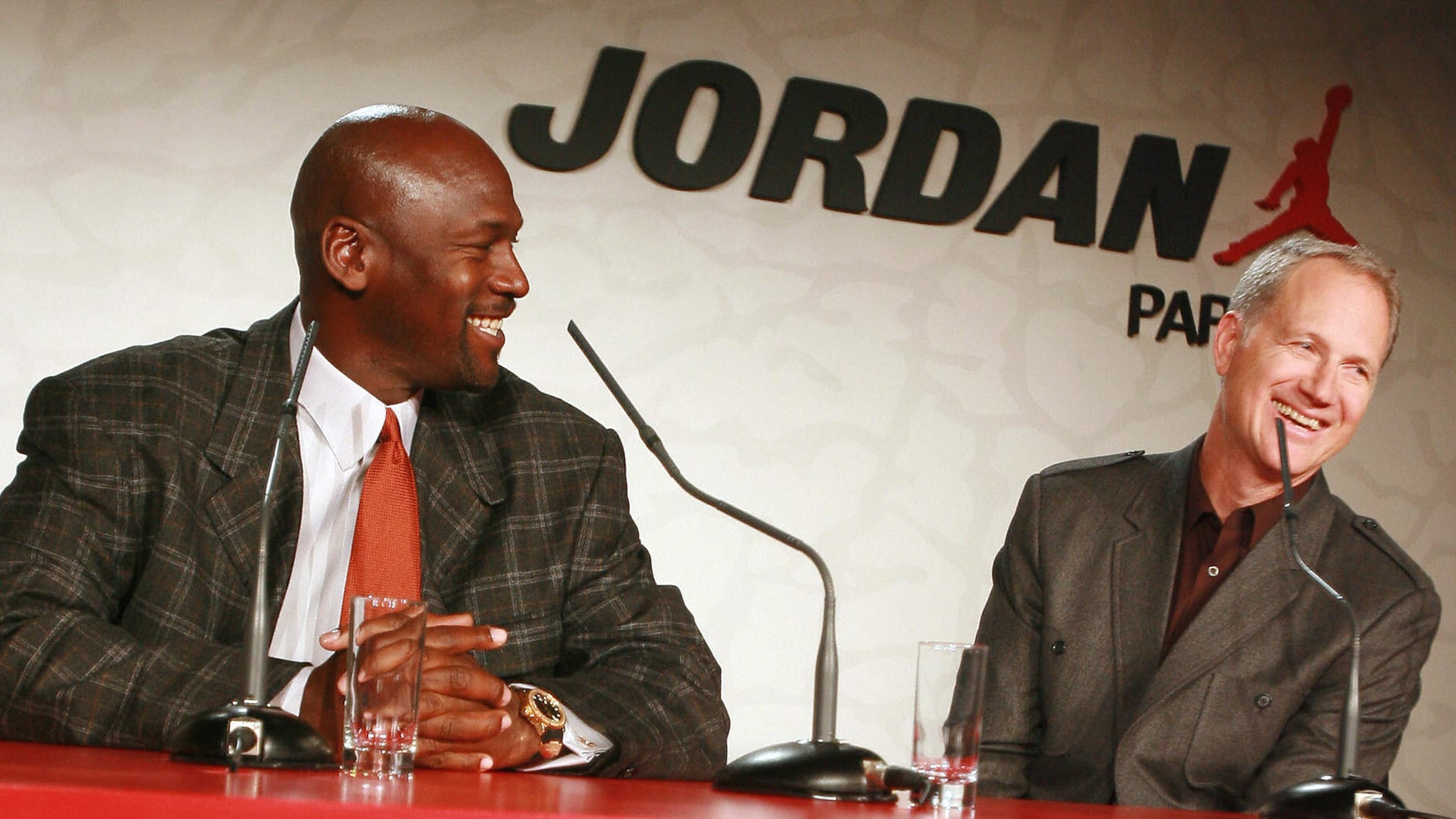
You mentioned working from an iPad—how much more of that have you done in this past year, or just working from home in general? Have you been to the Nike campus at all? What’s the past year been like for you?
I go to campus for meetings, but usually they’re one-on-ones with an executive. They might be strategy sessions, corporate strategy sessions, or they might be a specific touch-base meeting. I’m going to just take a wild guess that I’ve probably been to the campus maybe 10 times in the last year. And they’ve all been meetings with higher-up executives who I help strategize with.
How much different is that from your work life of the past 30 years?
It’s different from the perspective that the interpersonal relationships are important. Especially with the athletes, and through the design process, we’ve all had to adjust. We have to adjust and receive more information through these video screens, TVs and video screens, and, of course, through reading, in order to be informed and understand problems, and also individuals.
So, that’s a little bit different than traveling, and meeting with someone and hanging out. So, there’s been a little bit of an adjustment, but, having said that, I have designed probably more stuff in the last year, because I am not spending time on planes, I’m not spending time checking into hotels, I’m not spending time even driving out to the campus. So I have more time to sit down with my design tools and do work.
It’s interesting, because on one level, I feel like you have more time, but also maybe you have less experiences to draw from, and maybe you’re having to go through the stuff you’ve already recorded.
I think it’s a fair statement that fits in with what I said before about, everything that you’ve seen and done feeds into a design, or into an inspiration for a design. So, when the experiences drop off a little bit, you kind of have to, I guess, stretch a little bit, maybe in some cases, even manufacture a perception and hope that you’ve done a good job of that.
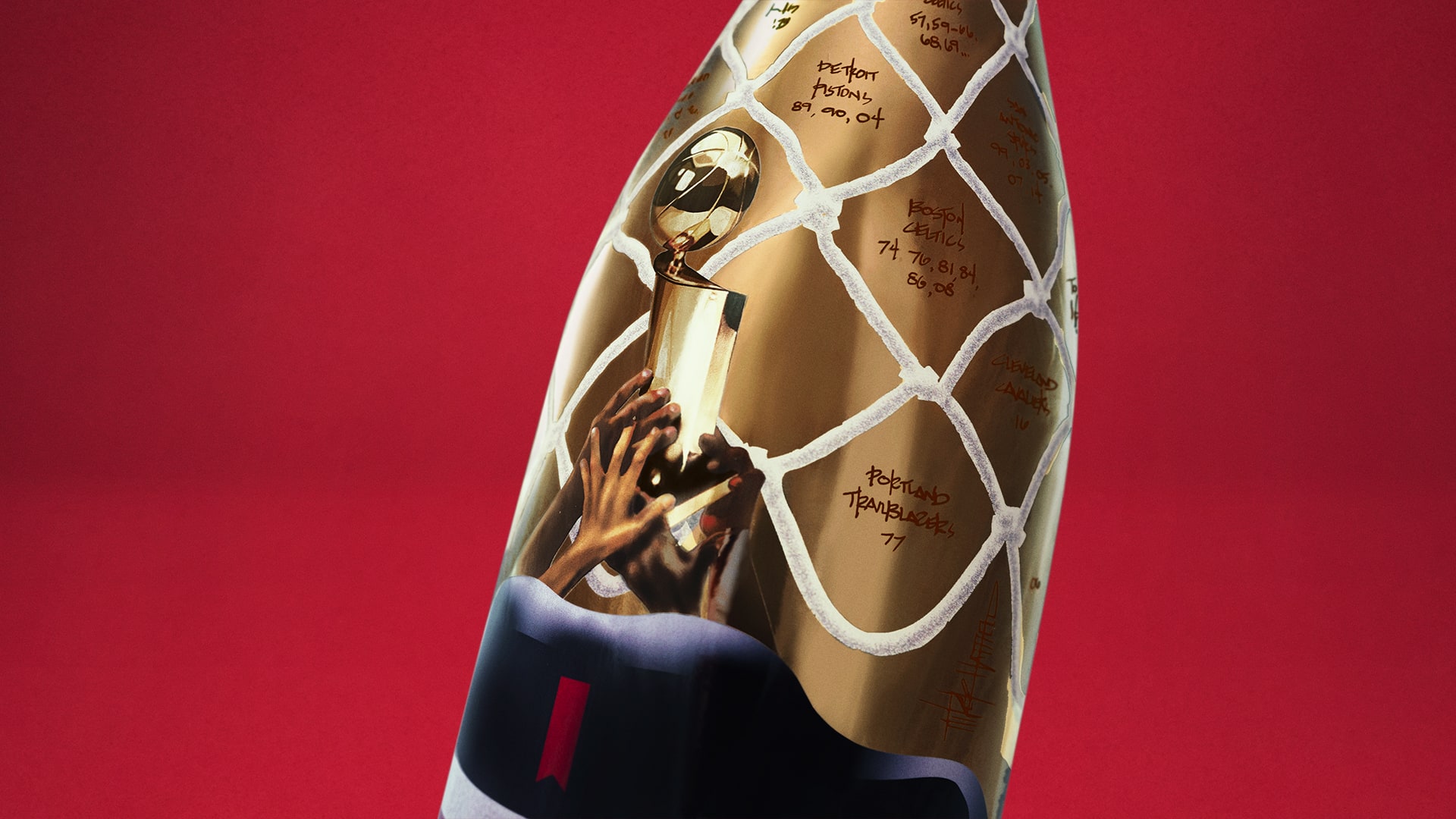
How much time have you been down at Hayward Field at the University of Oregon for the Olympic track and field trials these past couple weeks?
So, I only went for two of the eight days of competition because I have actually been too damn busy. Which again, we’re like—“we” meaning people like me in the design field—there’s a lot of work out there. There are a lot of requests. Michelob Ultra is one of those requests. So, I have to sort through requests outside of Nike, and then of course there are projects that essentially manifest themselves in new and interesting designs, here in my studio. So, there’s been a lot of work done, a lot of drawings, a lot of Zoom calls. Mentally, it’s been more hectic than I can remember, actually.
Does it hurt you at all as a designer to have to turn down so many things? I feel like it’s your role to solve these problems, so when you have all these opportunities come up it must feel frustrating, in a way, that you can’t do every single one of them.
It’s very frustrating. I try to be really judicious with the choices outside of Nike and also I have to be judicious with the Nike projects, too, because the quality has to be high. I have to put the brakes on sometimes, so that I’m not overstretched to the point that the work isn’t as good. So, there you have it, it’s always been the case that you have to be careful about how much you put on your plate. So, in this case, I’ve been spending a lot of time choosing.
That’s not to mention that I am still a practicing architectural designer. I’m no longer a registered architect, because I just don’t want to do all the work it takes to stay licensed, but I can still design architecture and I have a few clients. Also, my wife is probably one of my big clients, so I’m always designing stuff for her. She’s the toughest client of all time. But, she’s great because she knows what she wants, she knows what she likes, and so therefore there’s no real ambiguity, and that doesn’t necessarily cut down the amount of work, but the work is pretty pinpointed in it and done with the client closely.
The perfect client.
Yeah, very close.

